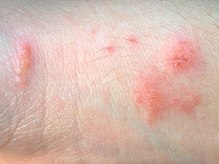| Urushiol-induced contact dermatitis | |
|---|---|
 | |
| Specialty | Dermatology |
| Symptoms | rashes, itching, inflammation, oozing, and, in severe cases, a burning sensation. |
| Causes | urushiol contact |
Urushiol-induced contact dermatitis (also called Toxicodendron dermatitis or Rhus dermatitis) is a type of allergic contact dermatitis caused by the oil urushiol found in various plants, most notably sumac family species of the genus Toxicodendron: poison ivy, poison oak, poison sumac, and the Chinese lacquer tree.[1] The name is derived from the Japanese word for the sap of the Chinese lacquer tree, urushi. Other plants in the sumac family (including mango, pistachio, the Burmese lacquer tree, the India marking nut tree, and the cashew) also contain urushiol,[2] as do unrelated plants such as Ginkgo biloba.[3]
As is the case with all contact dermatitis, urushiol-induced allergic rashes are a Type IV hypersensitivity reaction, also known as delayed-type hypersensitivity. Symptoms include itching, inflammation, oozing, and, in severe cases, a burning sensation.
The American Academy of Dermatology estimates that there are up to 50 million cases of urushiol-induced dermatitis annually in the United States alone, accounting for 10% of all lost-time injuries in the United States Forest Service. Poison oak is a significant problem in the rural Western and Southern United States, while poison ivy is most rampant in the Eastern United States. Dermatitis from poison sumac is less common.
- ^ "Urushiol". PubChem. US National Library of Medicine. 1 January 2022. Retrieved 4 January 2022.
- ^ Gross M, Baer H, Fales HM (1975). "Urushiols of poisonous anacardiaceae". Phytochemistry. 14 (10): 2263–2266. doi:10.1016/S0031-9422(00)91113-0.
- ^ Lepoittevin JP, Benezra C, Asakawa Y (1989). "Allergic contact dermatitis to Ginkgo biloba L.: relationship with urushiol". Archives of Dermatological Research. 281 (4): 227–30. doi:10.1007/BF00431055. PMID 2774654. S2CID 24855206.